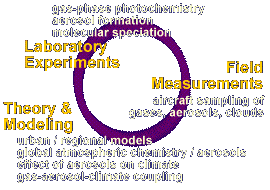Home
Publications
Research Group
Research
Courses
Biography
::
::
::
::
::
::
___________________________________________
S E I N F E L D
RESEARCH
___________________________________________
Current
Seinfeld Group Research Program in Atmospheric Chemistry and Physics

The Earth's atmosphere is a giant chemical reactor, and a major goal of our research is to develop a fundamental understanding of the chemical and physical processes that take place all the way from the polluted urban atmosphere to the global troposphere.
The study of atmospheric chemistry as a scientific discipline goes back to the 18th century, when the principal issue was identifying the major chemical components of the atmosphere: nitrogen, oxygen, water, carbon dioxide, and the noble gases. In the late 19th and early 20th centuries, attention turned to the so-called trace gases, species present at less than 1 part per million parts of air. We now know that the atmosphere contains myriad trace species, some at levels as low as 1 part per trillion parts of air. The role of trace species is disproportionate to their atmospheric abundance; they are responsible for phenomena ranging from urban photochemical smog, to acid deposition, to stratospheric ozone depletion, to potential climate change. Moreover, the composition of the atmosphere is changing: analysis of air trapped in ice cores reveals a record of striking increases in the long-lived so-called greenhouse gases, carbon dioxide (CO2), methane (CH4), and nitrous oxide (N2O). Within the last century, concentrations of tropospheric ozone (O3) and sulfate and carbonaceous aerosols in the Northern Hemisphere have increased significantly. There is evidence that all these changes are altering the basic chemistry of the atmosphere.
Atmospheric chemistry occurs within a fabric of profoundly complicated atmospheric dynamics. The results are often unexpected: witness the unique combination of dynamical forces that leads to a wintertime polar vortex over Antarctica, with the concomitant formation of polar stratospheric clouds that serve as sites for heterogeneous chemical reactions involving chlorine compounds resulting from anthropogenic chlorofluorocarbons -- all leading to the near total depletion of stratospheric ozone over the South Pole each spring; witness the nonlinear, and counterintuitive, dependence of the amount of ozone generated by reactions involving hydrocarbons and oxides of nitrogen (NOx) at the urban and regional scale -- although both hydrocarbons and NOx are ozone precursors, situations exist where continuing to emit more and more NOx actually leads to less ozone.
Figure 1. Coupling between Chemistry, Aerosols, and Climate (click here)
At once the most important and paradoxical molecule in the atmosphere is ozone (O3). Ozone in the stratosphere screens living organisms from biologically harmful solar ultraviolet radiation; ozone in the troposphere, at levels above those naturally present, has adverse effects on human health and plants. At the urban and regional scale, significant policy issues concern how to decrease ozone levels by controlling the ozone precursors, hydrocarbons and oxides of nitrogen. At the global scale, understanding the causes of continually increasing background tropospheric ozone levels is a major goal.
Aerosols are particles suspended in the atmosphere. They arise directly from emissions of particles and from the conversion of certain gases to particles in the atmosphere. At elevated levels they limit visibility and pose a human health hazard. There is a growing body of epidemiological data that suggests that increasing levels of aerosols may cause a significant increase in human mortality. For many years it was thought that atmospheric aerosols did not interact in any appreciable way with the cycles of trace gases. We now know that particles in the air affect climate and interact chemically in heretofore unrecognized ways with atmospheric gases. Volcanic aerosols in the stratosphere, for example, participate in the catalytic destruction of ozone by chlorine compounds, not directly, but through the intermediate step of NOx chemistry. Aerosols reflect solar radiation back to space, and, in so doing, cool the Earth. Aerosols are also the nuclei around which clouds droplets form -- no aerosols, no clouds. Clouds are one of the most important elements of our climate system, so the effect of increasing global aerosol levels on the Earth's cloudiness is a key problem in climate studies.
Figure 2: Atmospheric Aerosol Chemistry (click here)
Figure 3: Direct and Indirect Effects of Aerosols on Climate (click here)
Historically, urban air pollution and its effects were studied more or less separately from that of the chemistry of the Earth's atmosphere as a whole. Similarly, in its early stages, climate research focused exclusively on CO2, without reference to effects on the underlying chemistry of the atmosphere and their feedbacks on climate itself. It is now recognized, in quantitative scientific terms, that the Earth's atmosphere is a continuum. The urban atmosphere, the remote troposphere, the marine boundary layer, and the stratosphere are but points along the continuum from the smallest turbulent eddies and the fastest time scales of free radical chemistry to global circulations and the decadal time scales of the longest-lived trace gases.
Many projects in our group involve a balance between experimental and theoretical research, while others are completely theoretically based. Development of mathematical models for atmospheric phenomena involves many aspects of chemistry, physics, numerical analysis, and the use of supercomputers. Our experimental facilities for atmospheric research range from a 60 m3 outdoor transparent reactor to a 1 m3 photochemical reactor. We are active users of the parallel supercomputing facility at Caltech.